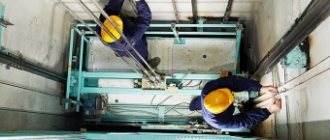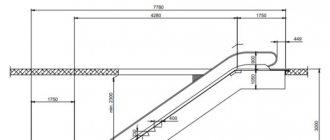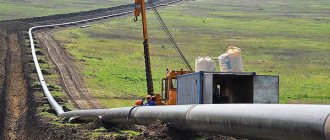Modern elevators are a mandatory structural element of an apartment building (hereinafter referred to as MKD), providing the ability to quickly ascend to the desired floor. To keep them in working order, special measures must be taken, including repairs and comprehensive maintenance.
Dear readers! Our articles talk about typical ways to resolve legal issues, but each case is unique. If you want to find out how to solve your particular problem, please use the online consultant form on the right or call. It's fast and free!
Criteria for determining the condition of an elevator structure
The main criteria for the condition of the structure when inspecting an elevator are as follows:
- serviceability of such elements as: winch, elevator doors, control system, lighting and alarm, communication with the dispatcher;
- mine fencing must comply with the requirements of PUBEL;
- the mechanisms for unlocking mine doors using an emergency key are checked.
What is the service life of an elevator in residential buildings?
The maximum service life of elevator structures is considered to be 25 years. Determining the possible service life of an elevator consists of the following indicators:
- requirements determined by GOST: the elevator cabin can be used for 25 years, mechanism parts up to 12 years and 6 months;
- data provided by the manufacturer;
- existing breakdowns (after they are eliminated, repeated testing is carried out);
- the degree of activity of using the lift.
The higher the level of maintenance of elevator equipment, the longer the structure can be used.
Types of repair work organized as part of the service
These structures belong to the class of complex lifting mechanisms, the maintenance of which must be carried out by specialized companies.
To do this, in agreement with the residents of the building, their authorized representative selects a specialized organization, with which a contract for servicing the elevators is subsequently concluded.
5 stages of creating an HOA, see the link.
When drawing up a plan for upcoming work, responsible employees of the service department must be guided by current regulations.
Who owns the elevator and who is responsible for its operation? Watch the video:
According to these documents, maintenance of lifting mechanisms in an apartment building is organized according to a standard scheme, which includes the following points:
- current repairs associated with minor equipment breakdowns;
- scheduled or unscheduled maintenance;
- planned major repairs.
Let's look at each of these technical activities in more detail.
Maintenance
This type of maintenance refers to the work required to maintain the elevator facilities of any high-rise building in good condition.
As part of such repairs, minor malfunctions and malfunctions are eliminated, as a result of which a pause in the operation of the MKD lifting equipment is not critical for its users.
Routine repair of elevator equipment involves the prompt restoration of its functioning mechanism in the event of an unexpected failure. At the same time, the main goal of this work is to maintain the operability of the lifting device and prevent emergency situations associated with the wear of individual structural elements.
Please note: As part of routine repairs, preventive actions are also carried out, which boil down to replacing unreliable or long-outdated parts.
The timing of this type of maintenance is established by current regulations relating to the operation of modern elevator equipment.
Maintenance
Maintenance means a whole range of preventive measures, including the following mandatory procedures:
- periodic inspections of elevator facilities;
- operational maintenance related to the elimination of suddenly discovered problems (it differs from repair in the limited intervention in the operation of lifting mechanisms);
- emergency maintenance associated with the release of citizens stuck in it from the elevator cabin and similar cases;
- unscheduled major repairs.
Each of these types of maintenance will be discussed separately below.
The elevator inspection is carried out by the company in accordance with regulations.
Inspections
When conducting visual inspections, specialists from the service company examine the main components of the MKD elevator equipment, with special attention paid to automatic lifting mechanisms.
At the same time, the condition of the supply cables and actuators (electric motors, in particular), as well as the automation responsible for the functioning of the entire system as a whole, is checked.
It is recommended to carry out periodic inspection of elevator facilities at least once a month, combining it with the ongoing elimination of minor faults that do not affect the performance of the device.
Operational and emergency maintenance
According to current regulations, operational maintenance is carried out in agreement with the customer, but at least once a year.
Additional information: Monthly or quarterly visits to the assigned facility may be considered as options for this type of service. Compared to regular inspections, the amount of work performed during such visits is not so great.
A feature of emergency maintenance is the emergency nature of providing assistance to citizens in an unpleasant situation with the subsequent restoration of the functioning of the faulty unit.
How to organize video surveillance in an apartment building? See here.
Unscheduled major repairs
This type of maintenance involves the complete or partial replacement of individual mechanisms in the design of elevator equipment.
Unscheduled overhaul involves replacing important components and mechanisms.
Conventionally, it is divided into the following three categories:
- small, in which minor faults are eliminated by replacing single worn-out elements or components;
- medium repairs associated with the need to change such system elements as the brake drive, traction motor, its gearbox and other critical components of the lifting system;
- large, involving the renewal of most mechanisms in a heavily worn-out structure.
Unscheduled repairs can be organized either directly at the troubleshooting site or in a specialized workshop (the choice of one approach or another is determined by the complexity of the work to be done).
Before carrying out it, a preliminary assessment of the upcoming work and selection of a repair category is required. This examination should be carried out with the participation of representatives from the HOA or from the housing management company (MA).
Upon receipt of a conclusion about the need for serious repairs, the owners have the right to insist on its immediate implementation.
Major repairs (planned)
For this type of repair, carried out according to a pre-agreed program, a collective decision of the owners of the elevator (tenants of the apartment building) is necessary.
You can learn about the functions and purposes of creating an HOA here.
Preparations for this important event are organized as follows:
- representatives of the residential management company must inform residents six months before the start of work about the possibility of carrying out major repairs within the established time frame;
- the owners of elevator property are required to make a decision within 3 months on the need for repairs or on the refusal of this measure;
- if a positive decision is made, the collective meeting of residents confirms it in writing, after which all the documentation necessary to organize the repair is drawn up;
- in the case where the owners were unable to decide on a specific solution, the timing of major repairs is set according to schedules approved within the framework of the municipal program.
Whether to carry out major repairs or replace the elevator now depends on the decision of the residents. Watch the details in this video:
To avoid mistakes when choosing a company specializing in repair work of this class, it is recommended to focus on the following signs:
- Availability of official status of a repair organization.
- Level of preparedness (qualification) of repair personnel.
- Strict adherence to regulatory requirements (compliance with standards and GOSTs).
- Availability of dispatch and emergency services that monitor the execution of work.
If the selected company meets all the above criteria, you can safely enter into an agreement with its representatives.
Elevator maintenance and repair
Maintenance and repair of the elevator, from the financial side, is the responsibility of the residents.
At whose expense is the repair carried out?
Maintenance, repair work and inspections of lift structures are paid for by residents. Residents of apartments located on the ground floor are not exempt from paying fees because they are co-owners.
Responsibilities of the management company for elevator maintenance
Lift maintenance includes the following work:
- 24-hour provision of safe operation of the lift that meets the standards;
- elimination of faults that may interfere with the operation of the elevator;
- routine inspections of structures in order to detect lift defects;
- preparation of documents for decommissioning of the structure;
- emergency repair of breakdowns.
All these points must be fully provided.
Where to complain about poor-quality repairs?
If you detect any malfunctions or unusual sounds, you should contact your management company or HOA. Another option is a written application from the residents, which must be submitted to the office of the management organization.
If the management company delays repairs or ignores messages from residents, you should report this to the housing inspection and district government. The complaint can be submitted using the electronic reception desk or submitted to the district inspector. After the complaint is considered, the management company will be obliged to eliminate the problems.
You should know that the management organization is responsible for all lift maintenance services, including the proper appearance of the cabin.
The Housing Inspectorate monitors the maintenance of common building property, including compliance with mandatory requirements for the maintenance of elevators in apartment buildings. In particular, the work of the dispatch service and contracts with organizations that provide maintenance of elevator structures are subject to verification.
Blog
The elevator is the common property of an apartment building (hereinafter referred to as MKD). Accordingly, any breakdown of it is a headache for the manager of the apartment building.
It should be noted that among the “abundance” of common property, the elevator is an important assistant in the life of the residents of the house and the timing of the consequences of its malfunction is strictly regulated by the current legislation of the Russian Federation.
In accordance with clause 4.4.5 of the Methodological manual for the maintenance and repair of housing stock MDK 2-042004 (approved by the State Construction Committee of the Russian Federation), for maintenance, overhaul and modernization of elevators, an organization servicing the housing stock can attract a specialized organization for elevators that has technical means and qualified specialists.
Based on clause 16 of Appendix No. 7 of Rules No. 170 (Decree of the State Construction Committee dated September 27, 2003), the list of works related to routine repairs includes the replacement and restoration of elements and parts of elements of special technical devices, performed by specialized enterprises under a contract with the owner ( body authorized by him) or with an organization servicing the housing stock, according to regulations established by manufacturers or relevant industry ministries (departments) and agreed upon state supervisory authorities.
Thus, at present, management organizations (hereinafter referred to as MA) enter into contracts with specialized organizations, but many MAs, when passenger (freight) elevators break down, do not find the correct algorithm for action in the event of such a “trouble.”
So what should the management company do if the elevator has become unsafe for transporting citizens or has simply become faulty, and also if the manager does not have the funds for its urgent repairs?
First, we advise you to pay attention to the clauses of the contract with a specialized organization for servicing elevators, where the terms for replacing parts are usually indicated. It should be noted that such organizations have a certain “repair reserve” of 2-3 percent (for example, to repair 3 elevators out of 100).
Taking into account the above, having in hand a joint report with the specialists of the elevator organization, you should send a written request to the elevator organization in order to eliminate the problem.
The work required to eliminate an elevator malfunction can be either the replacement (for example) of a gearbox bearing, which requires minimal costs, or the complete replacement of the gearbox itself, which has failed. Thus, there is a possibility that the equipment that was released will be adjusted by a specialized organization, with which it is no coincidence that the managers of the MKD have concluded a specialized agreement.
If you receive a negative response about eliminating the malfunction from the elevator organization (most likely due to the need to invest significant funds for repairs), on its basis, after receiving it, you can hold a general meeting of the owners of the apartment building premises on financing the replacement of the part of the elevator that has failed. In this case, Article 210 of the Civil Code of the Russian Federation applies to the management company (the owner is obliged to maintain his property).
All owners participate in the costs of maintaining elevator equipment, regardless of the location of their premises in the house, because these expenses are not expenses for the use of elevators as a means of transporting citizens and goods (Letter of the Ministry of Regional Development of the Russian Federation dated 03/06/2009 No. 6177-AD/14, determination of the RF Armed Forces dated 04/20/2016 No. 117-APG16-2).
Based on the Determination of the Constitutional Court of the Russian Federation of December 22, 2015 No. 3026-O:
“...Part 7 of Article 156 of the Housing Code of the Russian Federation, considered in systematic connection with other norms of this Code, including the first part of its Article 39, according to which the owners of premises in an apartment building bear the burden of expenses for maintaining common property in an apartment building, and with part one of its Article 156, according to which payment for the maintenance of residential premises is set in an amount that ensures the maintenance of common property in an apartment building in accordance with the requirements of the law, as well as taking into account the specifics of the management agreement for an apartment building (Part 2 of Article 162), aimed at maintaining of the specified property in a condition that meets sanitary and technical requirements, provides for the determination of the amount of payment for the maintenance of residential premises in an apartment building at a general meeting of owners of premises in such a building, taking into account the proposals of the management organization, based in accordance with the requirements of paragraph 31 of the Rules for the maintenance of common property in an apartment building house (approved by Decree of the Government of the Russian Federation of August 13, 2006 No. 491), on assessing the characteristics of a given house (composition, design features, degree of physical wear, technical condition, geodetic, natural and climatic conditions of location, etc.).
Thus, part 7 of Article 156 of the Housing Code of the Russian Federation does not imply placing on the management organization the burden of maintaining someone else’s property and, based on the actual circumstances of the case of LLC “Manager”, which do not confirm the occurrence of losses for the applicant due to underfunding by the owners of premises in an apartment building for the maintenance of property owned their property cannot be considered as violating the constitutional rights and freedoms of the applicant in the aspect specified by him.”
The above tips can help the MA only in the case of prompt action and the absence of:
a) cases of administrative offense;
b) instructions from the regulatory authority.
If the elevator malfunctions for a long time, the OU has the following risks.
Clause 3 of the Rules for the Maintenance of Elevators (approved by Decree of the Government of the Russian Federation dated June 24, 2017 No. 743) directly indicates the management organization as the “owner of the facility,” that is, the elevator, and obliges it to take a number of necessary measures. Similar provisions are contained in clause 5.10.2 of the Rules for the Technical Operation of Housing (approved by Resolution of the State Construction Committee of the Russian Federation dated September 27, 2003 No. 170): the management organization is the operating organization. And although a certain part of the relevant “elevator” work can only be performed by a specialized organization (clause 5.10.1 of the Rules for the Technical Operation of Housing), it is the management organization that is responsible for the compliance of elevator equipment with the requirements of TR CU 011/2011 “Safety of Elevators” and TR CU 010/ 2011 “On the safety of machinery and equipment”, and it is she who will be punished if malfunctions are discovered in the operation of elevators (Resolution of the Armed Forces of the Russian Federation dated March 27, 2018 No. 25-AD18-2, Eleventh AAS dated March 22, 2019 No. 11AP-1050/1, Sixth AAS dated August 29, 2017 No. 06AP-3992/17, Ninth AAS dated August 29, 2016 No. 09AP-36508/16). If previously the management organization in a similar situation was involved under Article 14.43 of the Code of Administrative Offenses of the Russian Federation (violation of the requirements of technical regulations), then from March 6, 2019, liability may arise under Article 9.1.1 of the Code of Administrative Offenses of the Russian Federation (Violation of requirements for organizing the safe use and maintenance of elevators; for simple violation of requirements - a fine of up to 40 thousand rubles, and for a violation that threatens life and health - a fine of up to 350 thousand rubles or suspension of activities).
Example of judicial practice:
By the decision of the Zvenigorod City Court of the Moscow Region dated February 20, 2021 in case No. 12-27/2017, the management organization was held administratively liable for stopping the operation of the passenger elevator. The court considered that the management organization had the opportunity to comply with the rules and regulations, for violation of which administrative liability is provided, but it did not take all measures depending on it to comply with them.
It should be noted that paragraph 6 of the Rules No. 491 dated August 13, 2006 defines cases of reducing the amount of payment for the maintenance and repair of residential premises to premises owners. These include the provision of services and performance of work of inadequate quality and (or) with interruptions exceeding the established duration. In this case, the MA may have an obligation to make a recalculation.
This fact is also confirmed by judicial practice:
Since the fee for the maintenance and repair of common property includes the fee for the maintenance of the elevator, this fee is subject to recalculation.
(Decision of the Arbitration Court of the Kostroma Region dated April 11, 2016 in case No. A31-981/2016).
An article on recalculation for elevator downtime can be read here
.
Taking into account the above, a trusting relationship with a specialized organization can help the management company in the prompt repair of part of the elevator device.
If the management authority has the opportunity, as soon as possible, to hold a general meeting of the owners of the premises in the apartment building in which the elevator has broken down, on the issue of financing the installation of the elevator. If the owners decide to refuse to finance the replacement of part of the elevator for its repair (lack of quorum), the management company will need to independently fix the problems and then file a lawsuit against the owners of the apartment building premises to recover these expenses from the management organization on the following basis:
In “problem” houses, replete with complaints from the owners of their premises, repairs must be done as quickly as possible. We should not forget that repairs to non-functioning elevators in apartment buildings must be carried out within 24 hours.
Only the absence of the necessary part in the locality, official documents about the timing of its delivery, a response from a specialized (elevator) organization about expensive repairs, the presence of a second elevator in the house (as an opportunity to transport goods and people) can “mitigate” the punishment of the administrative authority for untimely repair of the elevator.
continues to accept applications for the closed section of the forum. All the necessary information is here
.
You can discuss the article and ask questions on our forum or use the form below.
How to replace an elevator in a house?
In order for the decision to replace to be made, the consent of at least 2/3 of the apartment owners is required.
The elevator can be replaced in several ways:
- On your own: the financial costs of replacing the lift yourself are paid by the apartment owners. To reduce costs, you can resort to the services of an installation company that will provide installments for up to six months. The management organization of the building is looking for an organization involved in servicing elevators.
- Participate in the federal capital improvement program: the program offers cost sharing between apartment owners and the state. To include a house in the program, you need to collect documents and submit them to the commission. When considering an appeal, the commission takes into account the degree of deterioration of the structure, the service life, the condition of the entire building and the amount that residents are able to contribute for replacement.
Step-by-step instruction
Procedure for replacing an elevator:
- Request an opinion from the management company. The management company’s conclusion is issued after inspecting the lifting structure; the danger of its further operation must be confirmed.
- Gather homeowners. Residents should decide to replace the lifting structure earlier than planned. The decision is documented in the form of a protocol.
- Contact the city hall. After obtaining the consent of the residents of the house, you should submit documents (the conclusion of the management company and the minutes of the decision of the meeting of owners) to the local government authorities to postpone the replacement to an earlier date.
- Fundraising. It is possible to replace a structure earlier than the established date when the house has the necessary accumulated amount. Savings are collected through contributions for major repairs.
What is the difference between replacement and upgrade?
Modernization is the replacement of old components and parts with new ones in order to ensure the safety of the structure and extend its service life.
Modernization is divided into several types:
- comprehensive modernization (all elements except metal structures must be replaced);
- partial modernization (individual components are replaced on the recommendation of a specialist).
The replacement includes both sequential replacement of all elements, as well as adjustment and inspection of technical condition. The work is accepted by representatives of the management organization. The lift is replaced within one month.
Required documents
To begin the process of replacing the structure, you need the following package of documents:
- a document containing information about the management of an apartment building;
- technical passport of the house;
- information on the number and area of non-residential premises;
- inspection report of the lift with a description of its technical condition;
- conclusion of the authorized body, which confirms the need for replacement;
- replacement project and estimate.
Elevator maintenance work
Basic maintenance work includes the following list:
• Securing a mechanic at the site; • Organization of daily rounds; • Timely repairs; • Checking elevator equipment.
The last point assumes that the mechanic stops the elevator for maintenance and starts it back up after checking. The specialist also makes a decision on replacing certain components that have exhausted their service life.
The organization servicing elevators provides elevator dispatching services.
Paying for an elevator in an apartment building
This amount depends on several factors.
How are elevator maintenance rates set?
Apartment owners must draw up a list of services at a general meeting, agree on the conditions for the provision and implementation of these services and the amount of payment for the maintenance and repair of common property.
The payment amount is also affected by the method of managing the apartment building that the owners have chosen.
When choosing a management company, residents independently choose the amount of payment based on the organization’s proposals.
When choosing the HOA form, the amount of payment is determined by the governing bodies of the partnership or cooperative, based on the estimate of income and expenses.









